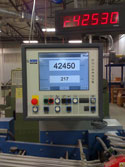 Folding machine operators have been benefiting from vacuum belt registration ever since it’s introduction, with better sheet control and higher speeds than conventional belt + marble configurations.
Folding machine operators have been benefiting from vacuum belt registration ever since it’s introduction, with better sheet control and higher speeds than conventional belt + marble configurations.
Yet no sooner is a technology introduced then it’s pushed to its limits in the field. Anyone who’s ever run a folder has heard the dreaded question, “You won’t have a problem running this, will you?” (That seems to be a standard question with any new piece of bindery equipment, by the way!)
When a folder is pushed to maximum or minimum design limits, challenges will arise. Vacuum belt systems usually have some type of adjustment for overall vacuum strength and for a bleed off level at the end of the belt just before the sheet enters fold roller 1—after all, the machine has to let go of the sheet at some point. When running smaller, heavy stocks with coatings, or light stocks at high speeds, the bleed off area doesn’t always provide all the control needed for perfect registration.
Here’s a clever solution from Reno Cyr Sr and Jerry Turgeon of JS McCarthy Printers that eliminates the registration problem and is shown getting near maximum speed from their MBO Navigator. Using an MBO transport wheel accessory and some home-made wood-and-clamp rigging, he positions the rig in the bleed-off area as shown in the photo (top left.) Adjust pressure on the transport wheel as needed, and any mis-register problems disappear.
 Photo 2 (right) shows a 2-up 11x17 letterfold, 40# text running at a blistering 42,530 sheets per hour…times two! Folding machine production at a rate of 85,060 pieces per hour “is attractive to any production manager” says Cyr, who has used this method on Stahl and MBO folders. The method also works well on folders equipped with pre-slitter shafts. (This system is similar to another registration tip for Rollem machines in a previous post.)
Photo 2 (right) shows a 2-up 11x17 letterfold, 40# text running at a blistering 42,530 sheets per hour…times two! Folding machine production at a rate of 85,060 pieces per hour “is attractive to any production manager” says Cyr, who has used this method on Stahl and MBO folders. The method also works well on folders equipped with pre-slitter shafts. (This system is similar to another registration tip for Rollem machines in a previous post.)
We're sure that with a few measurements, a machine shop could duplicate this rig with a single metal fixture, including the ability to adjust forward and backward as needed.
And don’t be put off by the speeds shown here if your machine is a little older; the goal is to find ways to increase your production incrementally. If a bindery tip yields an average increase in bindery equipment production of even 5% over the course of a year, it will make a big difference to your bottom line and to customer happiness. But as you see, greater increases with a little effort are possible.

